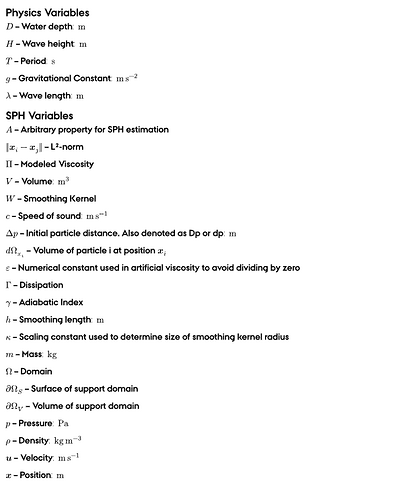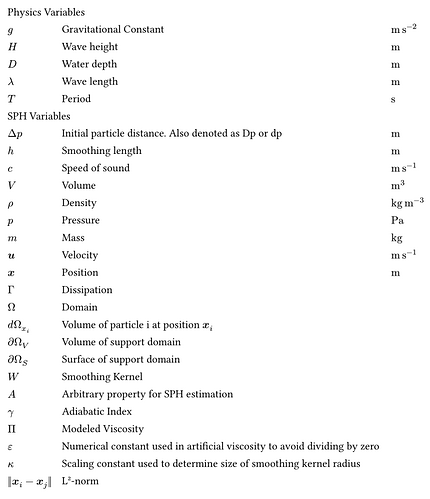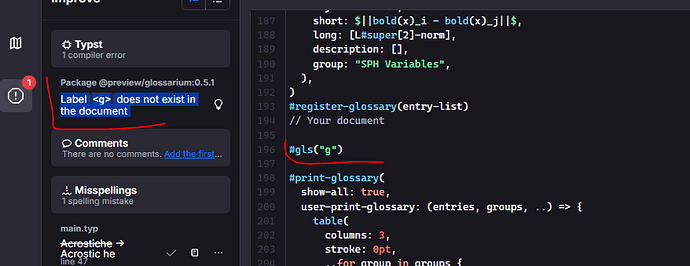Hello!
I am using the package glossarium to define a nomenclature. I need to define other “glossaries” later, such as “acronyms”, but for now what I have is:
#import "@preview/unify:0.6.0": unit
#import "@preview/glossarium:0.5.1": make-glossary, register-glossary, print-glossary, gls, glspl
#show link: set text(fill: rgb(160,20,40))
#show: make-glossary
#let entry-list = (
// Physics Variables (Group A)
(
key: "g",
short: $g$,
long: "Gravitational Constant",
description: unit("meter per second squared"),
group: "Physics Variables",
),
(
key: "H",
short: $H$,
long: "Wave height",
description: unit("meter"),
group: "Physics Variables",
),
(
key: "D",
short: $D$,
long: "Water depth",
description: unit("meter"),
group: "Physics Variables",
),
(
key: "lambda",
short: $λ$,
long: "Wave length",
description: unit("meter"),
group: "Physics Variables",
),
(
key: "T",
short: $T$,
long: "Period",
description: unit("second"),
group: "Physics Variables",
),
// SPH Variables (Group B)
(
key: "delta-p",
short: $Δ p$,
long: "Initial particle distance. Also denoted as Dp or dp",
description: unit("meter"),
group: "SPH Variables",
),
(
key: "h",
short: $h$,
long: "Smoothing length",
description: unit("meter"),
group: "SPH Variables",
),
(
key: "c",
short: $c$,
long: "Speed of sound",
description: unit("meter per second"),
group: "SPH Variables",
),
(
key: "V",
short: $V$,
long: "Volume",
description: unit("meter cubed"),
group: "SPH Variables",
),
(
key: "rho",
short: $ρ$,
long: "Density",
description: unit("kg/m^3"),
group: "SPH Variables",
),
(
key: "p",
short: $p$,
long: "Pressure",
description: unit("Pa"),
group: "SPH Variables",
),
(
key: "m",
short: $m$,
long: "Mass",
description: unit("kg"),
group: "SPH Variables",
),
(
key: "u",
short: $bold(u)$,
long: "Velocity",
description: unit("m/s"),
group: "SPH Variables",
),
(
key: "x",
short: $bold(x)$,
long: "Position",
description: unit("meter"),
group: "SPH Variables",
),
(
key: "gamma",
short: $Γ$,
long: "Dissipation",
description: [],
group: "SPH Variables",
),
(
key: "omega",
short: $Ω$,
long: "Domain",
description: [],
group: "SPH Variables",
),
(
key: "domega-xi",
short: $d Ω_x_i$,
long: "Volume of particle i at position " + $bold(x)_i$,
description: [],
group: "SPH Variables",
),
(
key: "omega-V",
short: $∂Ω_V$,
long: "Volume of support domain",
description: [],
group: "SPH Variables",
),
(
key: "omega-S",
short: $∂Ω_S$,
long: "Surface of support domain",
description: [],
group: "SPH Variables",
),
(
key: "W",
short: $W$,
long: "Smoothing Kernel",
description: [],
group: "SPH Variables",
),
(
key: "A",
short: $A$,
long: "Arbitrary property for SPH estimation",
description: [],
group: "SPH Variables",
),
(
key: "gamma-adiabatic",
short: $γ$,
long: "Adiabatic Index",
description: [],
group: "SPH Variables",
),
(
key: "Pi",
short: $Π$,
long: "Modeled Viscosity",
description: [],
group: "SPH Variables",
),
(
key: "epsilon",
short: $ε$,
long: "Numerical constant used in artificial viscosity to avoid dividing by zero",
description: [],
group: "SPH Variables",
),
(
key: "kappa",
short: $κ$,
long: "Scaling constant used to determine size of smoothing kernel radius",
description: [],
group: "SPH Variables",
),
(
key: "L2-norm",
short: $||bold(x)_i - bold(x)_j||$,
long: [L#super[2]-norm],
description: [],
group: "SPH Variables",
),
)
#register-glossary(entry-list)
// Your document body
#print-glossary(
show-all: true,
entry-list
)
It generates:
But I need it to generate this:
So basically I need to:
- Remove bold description text
- Set units to the right
- Sort entries such that entries with units go to the top for a neater look
I think this should be possible, I am just very uncertain on how to overload show in this case
Kind regards



